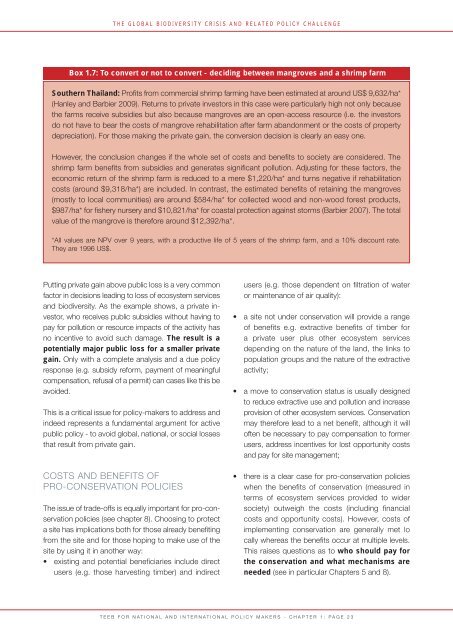Download (PDF, 6.71MB) - TEEB
Download (PDF, 6.71MB) - TEEB
Download (PDF, 6.71MB) - TEEB
Create successful ePaper yourself
Turn your PDF publications into a flip-book with our unique Google optimized e-Paper software.
THE GLOBAL BIODIVERSITY CRISIS AND RELATED POLICY CHALLENGE<br />
Box 1.7: To convert or not to convert - deciding between mangroves and a shrimp farm<br />
Southern Thailand: Profits from commercial shrimp farming have been estimated at around Us$ 9,632/ha*<br />
(hanley and Barbier 2009). returns to private investors in this case were particularly high not only because<br />
the farms receive subsidies but also because mangroves are an open-access resource (i.e. the investors<br />
do not have to bear the costs of mangrove rehabilitation after farm abandonment or the costs of property<br />
depreciation). for those making the private gain, the conversion decision is clearly an easy one.<br />
however, the conclusion changes if the whole set of costs and benefits to society are considered. The<br />
shrimp farm benefits from subsidies and generates significant pollution. Adjusting for these factors, the<br />
economic return of the shrimp farm is reduced to a mere $1,220/ha* and turns negative if rehabilitation<br />
costs (around $9,318/ha*) are included. In contrast, the estimated benefits of retaining the mangroves<br />
(mostly to local communities) are around $584/ha* for collected wood and non-wood forest products,<br />
$987/ha* for fishery nursery and $10,821/ha* for coastal protection against storms (Barbier 2007). The total<br />
value of the mangrove is therefore around $12,392/ha*.<br />
*All values are NPv over 9 years, with a productive life of 5 years of the shrimp farm, and a 10% discount rate.<br />
They are 1996 Us$.<br />
Putting private gain above public loss is a very common<br />
factor in decisions leading to loss of ecosystem services<br />
and biodiversity. As the example shows, a private investor,<br />
who receives public subsidies without having to<br />
pay for pollution or resource impacts of the activity has<br />
no incentive to avoid such damage. The result is a<br />
potentially major public loss for a smaller private<br />
gain. only with a complete analysis and a due policy<br />
response (e.g. subsidy reform, payment of meaningful<br />
compensation, refusal of a permit) can cases like this be<br />
avoided.<br />
This is a critical issue for policy-makers to address and<br />
indeed represents a fundamental argument for active<br />
public policy - to avoid global, national, or social losses<br />
that result from private gain.<br />
cosTs AND BENEfITs of<br />
Pro-coNsErvATIoN PoLIcIEs<br />
The issue of trade-offs is equally important for pro-conservation<br />
policies (see chapter 8). choosing to protect<br />
a site has implications both for those already benefiting<br />
from the site and for those hoping to make use of the<br />
site by using it in another way:<br />
• existing and potential beneficiaries include direct<br />
users (e.g. those harvesting timber) and indirect<br />
users (e.g. those dependent on filtration of water<br />
or maintenance of air quality):<br />
• a site not under conservation will provide a range<br />
of benefits e.g. extractive benefits of timber for<br />
a private user plus other ecosystem services<br />
depending on the nature of the land, the links to<br />
population groups and the nature of the extractive<br />
activity;<br />
• a move to conservation status is usually designed<br />
to reduce extractive use and pollution and increase<br />
provision of other ecosystem services. conservation<br />
may therefore lead to a net benefit, although it will<br />
often be necessary to pay compensation to former<br />
users, address incentives for lost opportunity costs<br />
and pay for site management;<br />
• there is a clear case for pro-conservation policies<br />
when the benefits of conservation (measured in<br />
terms of ecosystem services provided to wider<br />
society) outweigh the costs (including financial<br />
costs and opportunity costs). however, costs of<br />
implementing conservation are generally met lo<br />
cally whereas the benefits occur at multiple levels.<br />
This raises questions as to who should pay for<br />
the conservation and what mechanisms are<br />
needed (see in particular chapters 5 and 8).<br />
<strong>TEEB</strong> for NATIoNAL AND INTErNATIoNAL PoLIcy MAKErs - chAPTEr 1: PAGE 23

















